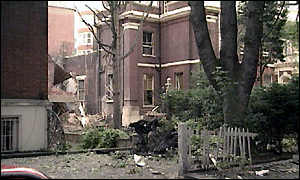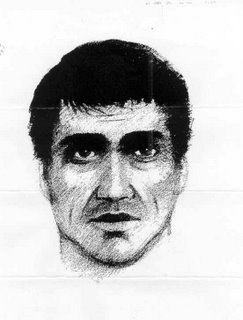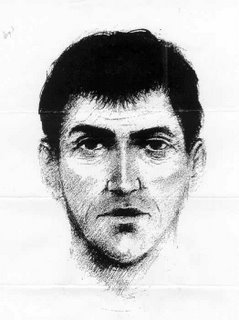Difference between revisions of "1994 London Israeli Embassy attack"
(Fix ref) |
m (Robin moved page 1994 Israeli Embassy Bombing in London to 1994 London Israeli Embassy attack) |
(No difference)
| |
Revision as of 08:50, 30 August 2014
"27 July 1994 , 1 a.m." contains more than three components required for a date interpretation.
 | |
| Date | 26 July 1994 - 27 July 1994 , 1 a.m. |
|---|---|
| Location | London |
| Coordinates | 51°30′10.44″N 0°11′20.76″W / 51.5029000°N 0.1891000°W Fatal error: The format of the coordinate could not be determined. Parsing failed. |
| Blamed on | Jawad Botmeh, Samar Alami |
| Type | 40px car bomb |
| Injured (non-fatal) | 20 |
| Exposed by | Annie Machon, David Shayler |
| Interest of | Paul Foot |
| Description | Two bombs in London, one in front of the Israeli embassy, one next to other Jewish organisations. It was blamed on Palestinians, but MI5 whistleblowers have claimed that an investigation by MI5 revealed that Mossad were behind the attacks. |
The Israeli Embassy in London was car-bombed on 26 July 1994 with around 30 pounds of explosives. The explosion blew out walls and caused a floor in the building to collapse. 14 people were injured, one with a broken arm. The Israeli Ambassador and British intelligence experts blamed pro-Iranian extremists linked to Hezbollah.[citation needed][When?]
Thirteen hours later at 1.00am, a similar car bomb exploded outside Balfour House, the Finchley, North London headquarters of several important Jewish organisations in London, injuring six bystanders with flying glass and shrapnel from the blast.
Five Palestinians were arrested in London in January 1995 in connection with the bombings. In December 1996, two of them, both Palestinian science graduates who were educated in the UK, Jawad Botmeh and Samar Alami, were convicted of "conspiracy to cause explosions" with evidence of their political activities in support of Palestinians portrayed as evidence of involvement in terrorism.
None of the evidence presented in the trial demonstrated any involvement by the two Palestinians with the bombing, only that the two had come across someone who was connected to it. "Reda Moghrabi" was never found and it is questionable whether any efforts were made to find him.
Nobody was convicted for the actual bombing and the woman who drove the first bomb, despite being seen and spoken to by police, was never identified or caught.
Both of the convicted Palestinians continue to protest innocence of any crime as do a number of commentators who took an interest at the time and since.
Contents
The two bombings
On July 26, 1994 approximately 30lbs of explosive packed into a grey Audi car with false number-plates was driven through the police checkpoint at Kensington Palace Gardens, London's main diplomatic quarter, and parked next to the Israeli embassy.
The woman driver, described as "of Mediterranean appearance" was smartly dressed in a navy jacket and skirt with matching sandals and a Harrods bag. She was challenged by an armed policeman of the diplomatic protection corps and claimed to be visiting flats next door, though she would first shop for some cigarettes in nearby Kensington High Street.
Seconds after she disappeared there was a considerable explosion that threw the car some 50 feet away and demolished part of the South Wing of the Embassy. A witness described seeing debris rise a hundred feet above the treetops and thirteen people were injured.
In the very early hours of the following morning another car bomb, this time a red Triumph Acclaim, exploded five miles to the north in Finchley High Road. The target, Balfour House, housed the London offices of, among others, the Jewish Agency for Israel, the Joint Israel Appeal and the World Zionist Organisation, all protected behind slit windows and double doors..Six more people were injured.[1]
1996 trial
Samar Alami and Jawad Botmi say they were "set up" by a man they suspect was working for the Israelis and whom they named as Reda Moghrabi. The police found no record of the man and did not seek to create an "identikit" of him.[2]
Gareth Peirce, Alami's solicitor, tried to obtain the film from the Israeli embassy security videotape camera that must have shown the bomber - only to be told that the security camera was not working on the day of the bombing.[1] Both the accused could prove that they were not at the scene of the bombing - Alami had been making a telephone call from the Imperial College library at the time, though she was only able to prove her alibi when her solicitor found that the telephone in the library recorded the time and number of calls. (Gareth Peirce is the solicitor who broke the prosecution's case in the Guildford Four trial).
The trial judge accepted that neither Samar nor Jawad belonged to a terrorist organisation.[citation needed] and in his summing up said: "Now I'm going to turn to the evidence members of the jury, forgive me if I say in some ways it is rather like trying to get a firm grip on a piece of soap in the bath".[3]
Both accused had plentiful opportunities to escape, six months went by between the bombs and their arrest, and months more passed when they were out on bail before the trial. They travelled extensively and went abroad, but returned to Britain normally.
They were sentenced to 20 years in jail, and lost their appeal in Nov 2001.
Prosecution case
The prosecution accepted that Samar and Jawad had no links to any regular terrorist organisations. Nevertheless, they proposed that the bombings were carried out by a small, previously unheard-of, amateur group of disgruntled British-based Palestinians, including Samar and Jawad, with no connections to any larger organisations in Britain or abroad.[4]
The two Palestinians, despite being regular peaceful activists and having no interest in bombings carried out in the UK, had taken part in limited experiments.
Defence case
The defence case was that the Palestinians had been entrapped by an agent of the real bombers, operating under a carefully constructed false name and persona, who had linked them to the terrorism by engaging their help buying one of the cars (the Audi used at the embassy) and leaving them with explosives before vanishing. There is no independent evidence of this man's existence, and the two Palestinians never had an address or telephone number. There were no business references, bank accounts, or credit cards for him.[1]
However, this revelation was largely ignored by the authorities - no description of "Reda Moghrabi" was taken from the two witnesses to a man who was presumably a key part of the terrorist gang.
At Gareth Pierce's instigation, Alami and Botmi put together their portraits of Moghrabi separately from each other - in two different prisons where they were being held - but the pictures are similar. From their memory of his words, it is also possible to reconstruct his story which, if he was an agent, is probably based on events that really happened. A Palestinian himself and, over the two years the accused knew him, he claimed to have been made a refugee repeatedly and to know about bomb-making.[5]
The jury presumably concluded that Reda Moghrabi was a fictitious character.[6]
But if so, Alami and Botmi have produced a mighty convincing portrait of the "Man Who Never Was". And since even Scotland Yard agree that the convicted pair did not carry out the bombing - that there was someone else who actually planted the bomb - you might expect the police to show a little more interest in the man with the staring eyes - Annie Machon.[6]
Withheld evidence
Subsequent to the trial and conviction of the two Palestinians on 2nd November 1997, former MI5 officer David Shayler revealed in an article in the "Mail on Sunday" that MI5 had received a written report containing specific information from a highly reliable source (as Shayler put it) warning of an imminent attack on the Israeli embassy[3] and had concealed evidence pointing to other culprits.[7]
The Home Secretary of the time, Jack Straw, claimed that the information would not have enabled it to prevent the embassy bombing.[2]
In August 1998, investigative journalist Paul Foot established from David Shayler that there was another hidden piece of information. A report written in September-October 1994 by a senior MI6[sic] officer involved in the investigation concluded that Israeli intelligence could have been involved in the attacks.[4]
Both pieces of evidence were withheld from court at the time of the trial - and it was three years before their existence became known to the defence as a result of Shayler's whistleblowing.
Public Interest Immunity
Prior to the trial of November 1996, Israeli and British investigators examined the crime scene for explosive traces. Defenders of Samar and Jawad claim that the forensic evidence found at the time points to a known terrorist organisation, with no known or likely connections to the two Palestinians.[4]
However, in terrorist cases, it is accepted that some parts of the investigatory process need to be kept secret, and the prosecution served a Public Interest Immunity (PII) order on evidence concerning the manufacture of the bombs.
Hence, the information obtained from the forensic investigation was shown to the judge but not to the defence. The result was to completely exclude a core piece of evidence from the trial.
At the Court of Appeal, October 2000, the prosecution were forced to admit that the existence of this potentially critical evidence had been concealed from the defence.
The Crown Prosecution Service applied for at least one more Public Interest Immunity [PII] hearing before the Court of Appeal of 2000, leaving the court to decide whether, in its view, the prosecution should reveal this information to the defence or not. All these arguments took place without the presence or knowledge of the defence.[2]
1998 delays
By November 1998, more than a year after the former MI5 agent David Shayler revealed the British security services were warned about the 1994 bombing of the Israeli embassy in London, Gareth Peirce, lawyer for the two Palestinians, was still waiting for the Crown Prosecution Service to give her information about who was behind the attack. She complained to the Director of Public Prosecutions about their failure to respond to her request but to no avail.[2]
2000/1 appeal rejected
At the Court of Appeal in October 2000, the prosecution admitted there had been a cover-up of vital evidence brought about by the use of a ‘PII’ order (‘Public Interest Immunity’) in Nov 1996. Evidence found at the bomb sites apparently suggested that a known terrorist organisation, with no connections to Samar or Jawad, was probably responsible for the bombings.[4] However, no trace of the explosive itself was ever found, it could have been TNT or Semtex[7] (a product much used for terrorism in Northern Ireland and elsewhere).
Leading defence counsel Michael Mansfield, QC stated to the Court of Appeal in 2000:
It is an astonishing and incredible failure in the duty of disclosure by those who are responsible ... a catalogue of disasters, errors and failures by at least eight different individuals, at seven different stages, beginning with the domestic security service and going all the way up to the Home Office .... Had it not been for David Shayler, the CPS would still be saying to us that there is nothing further to be revealed.[4]
Nevertheless, on 1st Nov 2001, Lord Justice Rose, sitting with Mr Justice Hooper and Mr Justice Goldring, said that there was "no demonstrated breach" of article six of the human rights convention, which guarantees a fair trial. The court also rejected a submission by their lawyers that their sentences were "manifestly excessive".
Aftermath
Jawad Botmeh was released from prison on 5 August 2008, Samar Alami followed in June 2009 and both were deported to Lebanon. Both continue to protest their complete innocence of any crime and their UK solicitor Gareth Pierce was emphatic that they were innocent.[6] The late Paul Foot, famous campaigning journalist agreed.[8]
Professional terrorists did it?
Robert Fisk, reporter for The Independent said that it is most unusual that two meticulously and professionally prepared bombings in the middle of London did not lead to multiple fatalities. (The bombing of 18th July, 8 days earlier, in Argentina killed 96). He wondered if this might indicate some Israeli involvement, perhaps as part of an attempt to persuade the British to increase security provisions.[4] The Guardian called it a "an extraordinary miracle that had most Middle East militants wondering what sort of organisation could have proved so ineffective".[1]
Two members of the jury complained to Mr Justice Garland that a reporter in the court had tried to contact them during the trial proceedings. One of the jurors stated that the reporter "said words to the effect: I've got a telephone number if you want it." The reporter - subsequently identified by The Independent as a journalist for Israeli radio, and who denied any attempt to "nobble" the jury - was interviewed by the police but allowed to remain in court during the trial.[2]
Annie Machon
Annie Machon is a former MI5 officer turned whistleblower, who in a 2009 interview stated about this bombing that
"... MI5's official assessment of this attack, after reviewing all the evidence and all the intelligence, was that Mossad had attacked their own embassy in a controlled explosion. They did this for two reasons: first to gain enhanced security around Israeli interests in London, and secondly to shatter a fast-growing Palestinian support network in which Alami and Botmeh happened to be active. This was one of the cases we blew the whistle on. You would think that there would have been an immediate retrial, but the government managed to avoid this as it would have justified the whistleblowing, and two innocent people continue to languish in prison."[9]
Related Documents
| Title | Type | Publication date | Author(s) | Description |
|---|---|---|---|---|
| File:InfiniteInjustice.pdf | report | July 2002 | Editorial staff | A detailed report on the background and status of the convictions of Jawad Botmeh and Samar Alami following the rejection of their appeal in November 2001. |
| File:Israeli Embassy Bomb Appeal book.pdf | report | January 2001 | Daniel Guedalla | A case that Samar Alami and Jawad Botmeh were framed for the 1994 London Israeli Embassy bombings and that their trial was a cover-up of a false flag attack. |
| File:Israeli embassy case.pdf | book extract | 1 January 2005 | Annie Machon | Chapter 14 of Machon's "Spies, Lies and Whistleblowers" which focuses on the 1994 London Israeli Embassy attack |
| File:JusticeDenied.pdf | report | 1999 | Daniel Guedalla | A report written in 1999 in the run up to the unsuccessful appeal by Samar and Jawad against their conspiracy convictions. Includes a preface by Paul Foot. |
The Official Culprits
| Name |
|---|
| Jawad Botmeh |
| Samar Alami |
References
- ↑ Jump up to: a b c d Caught in the blast Guardian 21 October 2000.
- ↑ Jump up to: a b c d e "Embassy bombing appeal is stalled" Independent 30 Nov 1998.
- ↑ Jump up to: a b Message from Jawad Botmeh 2000.
- ↑ Jump up to: a b c d e f The enigma of Israel embassy bombing, London 1994 Blog entry March 8, 2010. Cite error: Invalid
<ref>tag; name "terroronthetube" defined multiple times with different content - ↑ The bomber who never was. 26 November 1998.
- ↑ Jump up to: a b c The Israeli Embassy Two - a gross miscarriage of justice - Annie Machon blog June 2011
- ↑ Jump up to: a b Israel's London embassy bombed BBC 26 July 1994.
- ↑ The Extraordinary Campaigner "On the very day he died, [Paul Foot] was preparing yet another article cogently arguing the innocence of Jawad Botmeh and Samar Alami, convicted of conspiracy to bomb the Israeli embassy in London in 1996." The Guardian 12 October 2004.
- ↑ An interview with Annie Machon Anonymous blogger. 10th April 2009.


